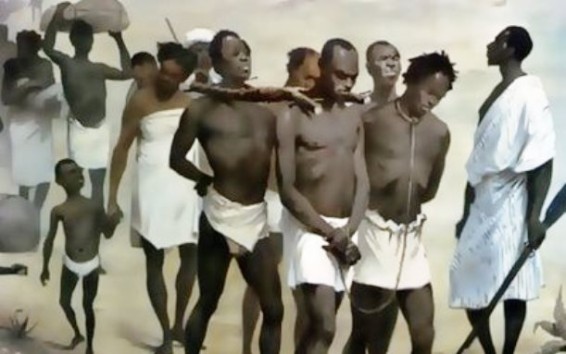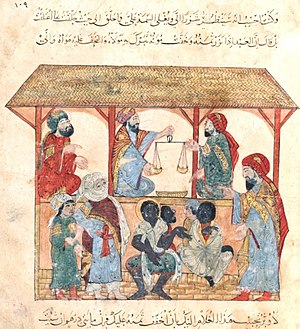4 Slavery: The Lynchpin of Empire
Jim Ross-Nazzal, PhD and Students
“Slavery informs all our modes of life, all our habits of thought, lies at the base of our social existence, and of our political faith.” –SC planter, William Henry Trescot, 1850[1]
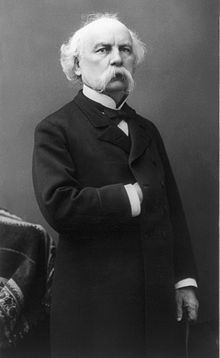
Lucy Terry Prince (c. 1732-1821)
Ms. Prince was a Renaissance woman according to so many websites. She was an oral historian. A poet. An orator. She passed along the traditions of the uneducated and spoke before the most educated in Vermont’s government. Again, as reported on so many websites. But those websites typically do not site from where they got the information, the narrative is linear, passive, and are contain relative terms. So much about Lucy Terry Prince do we really know?
Very little about how her life began is known. We think she might have been born in 1732, or thereabouts, somewhere in Africa but not specifically where in Africa. When she was a baby, she was taken into slavery and supposedly lived in Rhode Island. Maybe with a family possibly named Terry? Again, nothing terribly specific until 1737 when she became the property of Captain Ebenezer Wells of Deerfield, Massachusetts. Then in 1756 a freeman named Obijah/Abijah Prince purchased her freedom and married her. Lucy Terry would have been about 24 at that time.[2]
Every website touches upon her poetry. blackpast.org gives the one example I’ve found so far: “Around the age of sixteen Lucy Terry responded to a 1746 Indian ambush of two white families in a section of town known as “the Bars” by composing the ballad poem “Bars Fight,” which earned her local acclaim.”[3] That’s it. The author of that blurb did not explain what “acclaim” meant nor did she print the poem. Other websites mention that Lucy Terry Prince’s poetry was the spoken word not written, which was in the tradition of some African societies and that her first poem would not be published until 30 years after she had died. This poem, for example, was published 109 years after she wrote or performed the poem. I found the poem “Bars Fight” here, unattributed.
There is an award-winning PBS series called Africans in America. I found a little something about Lucy Terry in Part 2 of the online Resource Bank section. From there I can see where some of those other websites cut and pasted information to include the variations in the spelling of the name of the man who purchased Lucy Terry’s freedom.
According to Africans in America, Lucy Terry was owned by that ship captain noted above, was baptized when she was one year old but did not join a church or perform a ritual signifying her acceptance of Christianity until she was 20 -this would have been near the end of the First Great Awakening. She and Prince had five children, they were able to get the assistance of the governor of Vermont in a land claim that smacked of racism and she argued against what sounded like racial reasons why one of her sons could not be admitted to Williams College. And according to that bio, Lucy Terry Prince argued a land case before the Vermont Supreme Court and won.[4] That is it from that PBS website.
Africans in America have been on the web for a long time (1998), the site is huge, and not all links are maintained. For example, the link to Lucy Terry Prince’s poem “Bars Fight” is dead.
But that PBS site does not cite where it got that information from. I did come across an obituary that some websites referenced, but there was nothing of terrific substance there. She was four when Ebenezer Wells took her from Rhode Island to Deerfield, Massachusetts. She was married on May 17th, 1756 by Elijah Williams and has seven children. She lived to be 97. The obit, using traditional, flowery, nineteenth-century prose, heaped praise upon Lucy Terry Prince’s knowledge of the Bible (“the word of God has been her study and delight”) and noted over and over again that she spoke exceptionally well. “All considered her a prodigy of conversation,” and that her speaking skills “captivated all around her.” But no specifics outside of religion and speaking. Nothing about any court cases, her work in what may be called civil rights today, and certainly nothing about any poetry.[5]
See how the tweet by the Vermont State Archives passes along the inaccuracy that Lucy Terry Prince argued a case before the US Supreme Court. She spoke before the Vermont Supreme Court. The Vermont State Archives then tweets that she died in 1821 and as her obituary said she was 97 at death, she had to have been born in 1724. The second tweet only references her poem “Bars Fight.”[6]
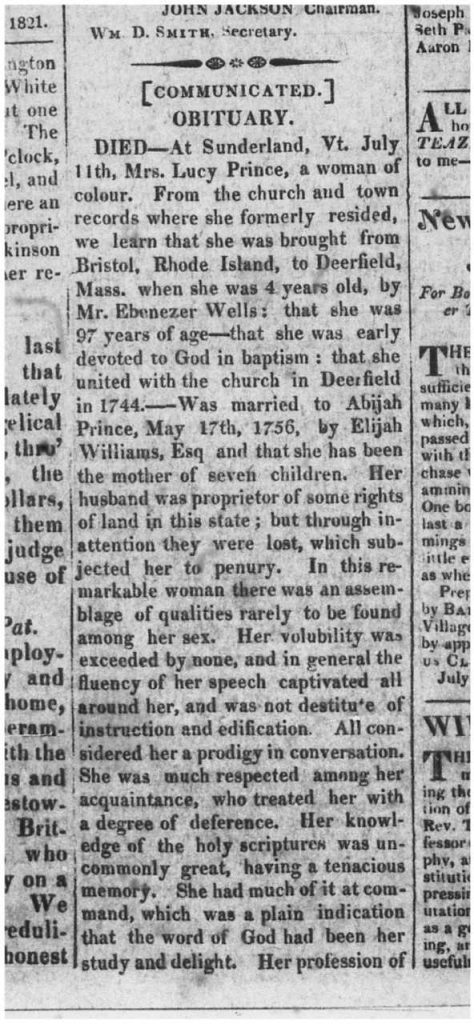
There is no consensus as to what she looks like. Here are just three renditions I came across:
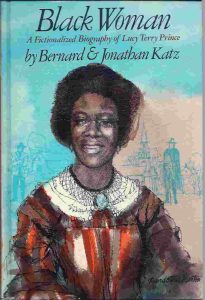
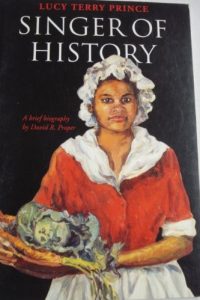
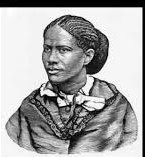
And then there are some websites that confused images of Phillis Wheatley as Lucy Terry Prince. Some people claim this image to be Lucy Terry Prince on their websites, but the image is actually of Phillis Wheatley and appears on several book covers as well as professional and academic websites. (right-click – search Google for image)
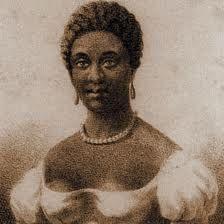
So what’s the purpose of this? The purpose is multi-folded. First, cite your sources. Readers need to know where this stuff came from. Second, and this is the BIG ONE. ho is Lucy Terry Prince? How do we know what we know? It is seemingly much about her life post-freedom, but if you dig a little, you will find out that so much of what we think we know about this person has not been attributed to any sources. With relative ease, a researcher can find out if she did indeed represent her family in the case before the Vermont Supreme Court, or petitioned Williams College to change their admissions policy, as some websites purport she did. But what about the names of her children? And what happened to them? Genealogy can be difficult at times but a properly trained researcher knows where to look. We think we know what we know. Keep your eyes open and think, think, think as you read this and every chapter. Ask yourself, “How do we know this?” Look at the source. Analyze the source. Not all evidence was created equally. But we do need evidence to begin the process of adding the words and deeds to individual people and History is the culmination of the words and deeds of individual people. Ok, on with Slavery: The Lynchpin of Empire.
Population
The African population increased dramatically as a result of Bacon’s Rebellion and the decision of Governor Berkely to end the indentured servant system and what all but initiated the massive importation of African slaves. By the time of the American Revolution, approximately 20% of the population was of African descent.[7] And the majority of people of African descent lived in the Chesapeake during the American War for Independence. Now not all were slaves, the majority of black people were slaves but not all. Numbers vary but no more than 10% of the overall African population was free.[8]
For example, there were approximately three-quarters of a million people of African descent in the US by 1790, half of which lived in Maryland and Virginia.[9] During the seventeenth century, British subjects were the largest ethnic group coming to the colonies and then overwhelmingly to Virginia, Massachusetts, and the Caribbean islands. In the eighteenth century the largest ethnic group of “newcomers” were African slaves.[10]
The population of the United States in 1790 was about 4 million, of whom 60,000 were free blacks and 400,000 were slaves. The largest contributor of colonists to the Americas was Great Britain. During the 17th century, about 250,000 English immigrants arrived, settling primarily in Virginia, Massachusetts, and the Caribbean islands. In the 18th century, more than 1.5 million people came from the British Isles to America. The majority of newcomers to the Western Hemisphere, however, were African slaves. About 10 million slaves were brought over by 1800.[11]
The slave population of some states (South Carolina, Louisiana, Mississippi, and Alabama) outstripped their white populations before we get to the Civil War. Realities as that must have made the governments dig their heels in deeper. We will cove that in all due time.
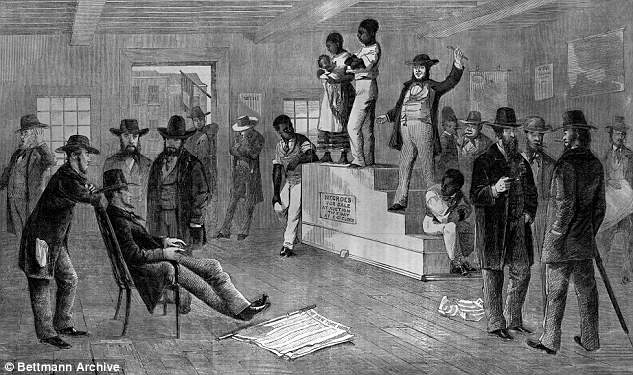
Beginnings of African Slavery
England, or even the British colonists in colonial North America, did not invent slavery. Slavery has been around for eons. In fact, Europeans were rather late in the history of slavery. Ancient Mesopotamians held slaves. Ancient Egyptians owned slaves. Greeks owned slaves. Roman owned slaves. Every ethnic group was somehow complicit in slavery. Jews, Christians, and Muslims owned slaves. And eventually, European nations will allow slavery. What’s different about the European history of slavery is that Europeans will expand slavery from outside the shores of Africa to Europe and the Western Hemisphere and in doing so will transport tens of millions of people out of Africa. Certainly, slavery was a major part of the Colombian Exchange. The Portuguese took over trade posts from Arabs who withdrew as a result of the Reconquista, then were the first to establish Portuguese colonies along the west coast of Africa. The Portuguese also established sugar plantations in the Canary Islands, which are located northwest of Africa. And the Portuguese imported Africans to work in their Canary Island sugar plantations as slaves. Sugar production is incredibly labor-intensive and so the Portuguese coupling new sugar plantations so close to potential labor sources is not surprising.
The use of Africans as slaves in Europe was not unknown at that time. The reality of fifteenth-century European land laws attached people to the land and thus landowners tended to use peasants or serfs as fieldworkers and African slaves were used outside of agriculture. Although it was highly unusual to see African slaves in European cities. Africans were not used widespread at that time. Although some Portuguese may have attempted to capture Africans themselves to be used as slaves, the method universally adopted was simply paying someone else for the slaves. Initially the Portuguese would pay Arab slave catchers, then as other European countries became involved in the use of Africans as slaves (the Spanish and English for our purposes) Europeans would pay Africans to capture other Africans to be used as slaves. Some of the problems today on the west coast, equatorial Africa (from border issues to outright warfare) can be traced to these events.
Down the Rabbit Hole
When the Spanish established colonies in the Americas, they will initially try to use Native Americans as slaves. That does not work so when the Spanish turned from Indians to Africans for slaves, they too took Africans from the West coast of Africa. When the English got involved in the African slave trade, to bring workers to their own sugar plantations in the Caribbean, England used Africans from the West coast. There were several reasons why European powers used in particular Africans from the West coast.
First, West coast Africans knew how to grow and harvest sugar. Remember, sugar was not new to that part of the world. Sugar was brought into the Western Hemisphere from Europe via Africa. Second, equatorial Africa is hot, humid, and wet. Conditions that are prevalent in sugar plantations in the Western Hemisphere. In other words, West coast Africans were used to working in such extremes of weather. Now, mosquitoes thrive in hot, humid, wet conditions such as in equatorial Africa, the colonies of Virginia, the Carolinas, and Barbados. Europeans did not know why; all they knew is that equatorial Africans rarely got sick with malaria -a disease carried by mosquitoes. Of course, we know that people of African descent are relatively immune to malaria because of a blood trait called sickle cell anemia, a dangerous genetic disorder in its own right.
It’s not what they planted but how they planted and harvested that mattered. American Indians planted small plots of corn, beans, and squash. West coast Equatorial Africans planted huge rows upon rows of wheat. They knew how to handle cattle (Indians did not have cattle) and they were accustomed to working in hot, humid conditions (like in the Chesapeake and American South). Europeans rarely caught the slaves themselves. In other words, West coast, equatorial Africans’ farming, and ranching more closely resembled the English way.
Navigation was relatively easy. As someone who lives in Houston, people along the Third Coast keep an eye on what storms roll off Africa’s equator in the Spring and Summer. Those thunderstorms follow the trade winds and ocean currents and can easily end up as named storms here in Houston (Harvey 2017, Ike 2008, Rita 2005, Allison 2001). Once those storms hit the Caribbean they can also be channeled up the east coast hitting the Carolinas. The ease of navigation was why Charleston became the port of entry for African slaves. English settlers needed/wanted Africans.[12]

The Middle Passage
Again, Europeans would pay one tribe to attack another tribe, usually occurring in the middle of the night. The attackers would carry off the prospective slaves, tie them up, then march them to the coast, where Europeans waited. Once on the coast, Europeans would separate Africans: men, women, and children would be placed in holding pens, sometimes being branded with the mark of the ship’s captain in case they escaped. People of different languages or dialects would be chained together to prevent communication and thus to instill the feeling of isolation.
In ships that brought 200 or 300 European colonists to the Americas, those same ships transported 400 to 600 African slaves, chained together, in the ship’s hole (below the waterline); bound to shelf-like devices in which the slaves were either lying on their backs or in spoon fashion. Slaves would be chained below deck for about 20 hours a day. Then in small groups, the white sailors would bring batches of slaves up on deck. Slaves would be given something to eat, usually no more than a handful of rice cooked in a fish broth (maybe 200 calories a day). The slaves would be rinsed off (remember, they were chained below deck for 20 hours at a time, meaning they urinated, defecated, and threw up on themselves and those nearby). Finally, they would be made to “dance” or “jump the negro” for exercise. Then the slaves would be escorted back below deck, where they would remain chained for another 20 hours.
The route from Africa to the Americans was known as the Middle Passage because it was the middle of a three-leg route: Finished goods from Europe to Africa, slaves from Africa to the Americas, and the slaves would grow/collect raw resources which were shipped back to Europe to be made into finished goods. Depending on the weather, time of year, current strength, and destinations, it would take anywhere from a few weeks to a few months to make it to an American port. The number one port of entry of African slaves into the British colonies of North America was Charleston, South Carolina. So many Africans went through Charleston that today 25% of all African Americans can trace their roots back to Charleston.[13]
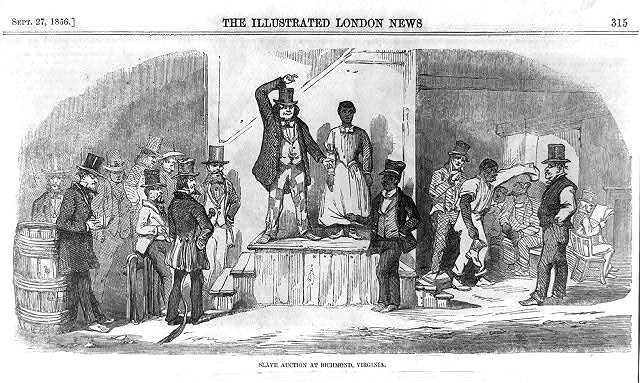
Slavery in the Colonies
Slavery manifested differently in different parts of the British colonies of North America. The Chesapeake. In the Chesapeake (present-day Virginia, Maryland, and Delaware) your average slave owner owned one slave. Slaves were used to working the labor-intensive tobacco harvest. Tobacco was harvested once a year and so slaves only toiled in the fields for a few months out of the year. Thus a secondary use for slaves in the Chesapeake was the leasing of slaves to other families. Leased slaves worked in fields or sometimes in the homes of their new masters. As the Chesapeake workforce tended to be populated by criminals, there was little need for slaves, except for the tobacco harvest.
What we would call the Middle Class owned slaves in the Chesapeake such as politicians, teachers, lawyers, doctors, and business owners. There was very little commercial farming in the Chesapeake due primarily to the limited growing season (ie, Winter). The Lower South. From the Carolinas to Georgia slaves tended to work year-round as the weather provided for multiple harvests. Initially, the majority of southern slaves were on the British island of Barbados, working in the sugar cane fields. Remember, the colony of the Carolinas was created to supply food for the slaves and slave owners in Barbados.
Slowly, however, slave owners realized that the weather and soil from the Carolinas to Georgia could result in year-round farming and so slave owners moved their slaves to the American south. Farms tended to be larger in the lower South than in the Chesapeake, and farmers worked a variety of crops such as rice, indigo, and tobacco meaning there would be year-round harvests, meaning there was a need for year-round slaves. Your average British colonists living in the south owned just a few slaves. A far cry from the novelization of the plantation in Gone with the Wind.[14]
The North
Slavery existed in the north, but for very specific reasons. For example, most slaves would be encountered working the major ports such as Boston or Baltimore, or New York City. These slaves would be owned by the various ship captains and their jobs were to load and unload the ships. The socio-economic make-up of northern colonists was the nuclear family: dad, mom, and six or eight children. Northern families farmed just enough land to bring them enough food to live, no more no less. But sometimes the children were too young to help with the harvest, thus you might see a Northern colonist renting a slave for a few days. Likewise, when your spouse was about to have a baby, you might rent a female slave to assist with the childbirth or cook food while your wife recuperates.[15]
Ben Franklin noted that slaves were omnipresent in Philadelphia, the City of Brotherly Love, on Sundays. He scratched his head in wonder. You see, once upon a time, clothing was proscribed based on your socio-political status in British life. And the highest-ranking people, those who had familial connections with the royal crown, could sport clothes dyed in purple. However, with the widespread use of indigo, everyone could wear purple clothes, and they did. Wealthy people needed a new symbol of their wealth. Something that showed the underclass that they were wealthy and privileged. And so the very wealthy in Philadelphia would purchase one slave, dress them up, and take them along with the family to church each Sunday so that everyone can see just how wealthy and important they were. Something akin to the rage in the early 21st century when “celebrities” carried pocket dogs wherever they went. Franklin even proposed a plan to help educate the slave children of his adopted city.[16]
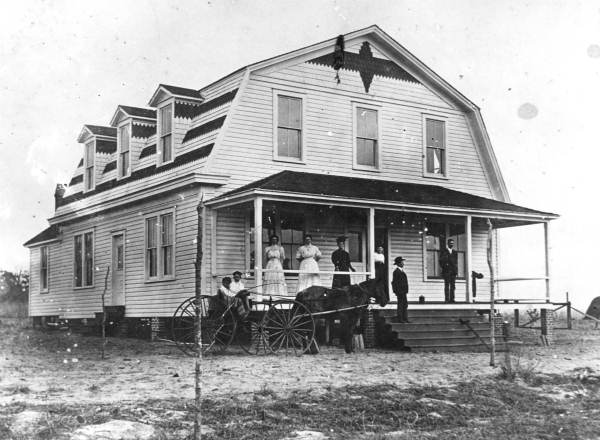
Naiya Childs, Luna Amelia, Myska Nasiri, Selena Ordonez, Kathryn Page, Javier Martinez, Josue Perez, Jose Ramos, Lauren Rivas and Jesus Zayas looked at slavery in colonial New York:
This essay will outline slavery within the colonial period which lasted between 1607-1776, focusing specifically on New York and the laws and regulations enforced on enslaved individuals, as well as the duties the slaves were given. In New York, New Netherlands in the colonial time, slavery really began with the arrival of the first slaves in 1625.
In the year 1625, the first African slaves were brought to New Netherlands, which was later renamed, New York. The first African slaves were not originally brought over from Africa, instead, they were captured from a West India Company.[17] They were then released to New Netherlands to reduce the colony’s labor shortage. The enslaved men were used to create construction projects, while the enslaved women were considered servants.[18] While the slaves were doing their instructed task in groups or individually, they had an appointed Company Officer watching over them whom they called the “Overseer of Negros”. If some slaves were not doing construction, they were enacted to do military services, such as in the first Indian War where they were given tools to defend themselves. The purpose of the first slaves in New Netherlands was for colonial development of agriculture settlements and construction.[19] Though around 1628 the projects began to subside, slaves became useless, and the West India Company leased out the land along with the slaves that came with it.
During the ruling of the Dutch, slaves were not owned, instead, they were looked at as servants.[20] They did not have total freedom but despite that, they could own land. Years later in 1644, life became harsher for every slave when the British captured New Amsterdam. New laws were created to restrict freedom for slaves and changed their lifestyle with no warning. One particularly harsh law that was implemented by the English prohibited the holding of Christians unless it was a punishment as criminal. Fear rose in slave owners so the English decided to establish a new law following the one previously mentioned that even if a black person was baptized, this did not mean freedom for them.[21] Life became harder and much stricter as the years went on and more laws were implemented but not only for adults. In 1650 a company declared that slaves can be manumitted after their long-term service but under the condition that their children would do free labor whenever the company pleased.[22]
This change of lifestyle caused slaves to flee up north to Canada, which resulted in a new act to try to prevent them from continuing to flee out of the city.[23] This new act created limits on how far a slave can travel alone, any slave that belonged to anyone inhabiting the city of Albany cannot go past a certain area called Sarachtoge unless accompanied by their owner.[24]
The colony of New York had some of the harshest slave codes when compared with other colonies.[25] That being said, the slave codes were only enforced mildly. The laws of New York accounted the enslaved as the property and personality of their owners, also known as Chattel.[26] The code 1712 stated the capital crimes a slave could commit included murder or attempted murder of a freeman or slave, rape or attempted rape of a free woman, and damage to a dwelling.[27] Examples of a dwelling were a house, barn, outhouse, or corn stalks. Had a slave committed rape, the slave would either be burned alive, hanged, or incarcerated. The owner of the rapist slave would then receive compensation after the slave was executed. If a slave was charged with the crime of assault or theft, the slave would face fourteen days in prison.[28] Slaves also had heavy restrictions placed on how many slaves could assemble at one time with no more than 3 slaves per group. In March 1684 there was even a law passed stating no slaves in more than a group of four should meet on the Lord’s day.[29] These laws and codes are just a few examples of the restrictions slaves were forced to adhere to.
The enslaved people within the New York colony dealt with some of the harshest laws given to slaves within the colonies. They also handled many obligations such as construction projects, development in agriculture, and even military services. The regulations were set in place to keep those enslaved within the system, while the whites in the colony benefited from those regulations and enriched the economy as well as the agricultural state.
One notable black man who rose against the English was a man named Jupiter Hammon. Hammon was a preacher and a poet born into slavery on the estate of Henry Lloyd on long island, New York where his slave owners trusted him enough to educate him.[30] He used his poems to fight against slavery, his first one called “An Evening Thought,” where he writes about praying to Jesus Christ to free all men from imprisonment. The poem ends by calling for Jesus to give salvation and bring equality to all.[31]
Slavery in Delaware[32]
Human chattel slavery in what is now Delaware dates to the early 1600s. The European Christians first tried to enslave the indigenous population, but that proved unsustainable. The Dutch brought the first slaves to their colony in 1626.[33] The first known African slave was given the European name Anthony. Control of the area passed between the Dutch and the English which saw the growth of both the European and enslaved populations. The West India Company, run by the Dutch bought most of the slaves to the colony[34]. The English brought with them their own religious way of life. Since the Church of England could not rely on taxation in Delaware, the Society for the Propagation of the Gospel in Foreign Parts was established in London in 1701 to provide the colonies with English clergymen. They sought to minister to white Church of England members, the indigenous, and enslaved populations. Again, the SPG could not rely on taxation in Delaware, so they had to resort to slave labor. In 1710, the SPG acquired Codrington Plantation in Barbados and cemented their support for slavery. On top of the money, the SPG was receiving from the Codrington Plantation, clergymen in Delaware owned and passed on slaves. The Rev. Mr. Phillip Reading and The Rev. Mr. William Becket both bequeathed their slaves to their families upon their deaths.
The main crop for Delaware was tobacco, corn, and wheat. At first, the Europeans tried using Native American men as their slaves but they weren’t good at taking care of crops because the women would be the ones who did that.[35] The Native Americans also didn’t know how to take care of the livestock because they weren’t used to those animals. The Europeans thought the Native Americans weren’t good at doing what they wanted, so that led to them wanting slaves from Africa. The Dutch were the first to bring them over, so then the Europeans started buying slaves from them.[36] They would grow tobacco, corn, and wheat, on the soil before having to either fallow it for not having enough nutrients or abandon the fields. This led to water building up in the fallows where mosquitos started populating there.[37] These mosquitoes carried malaria which caused anyone who wasn’t genetically immune to it to get weaker.[38] So Europeans wanted African slaves because they noticed they weren’t getting weaker so they wanted them in malaria-infested areas.[39] Other than the crops they would take care of they would also take care of the livestock such as sheep, cattle, pigs, and oxen.[40]
Due to the religious background of those in Delaware and Pennsylvania, the Quakers, the colony had been trying to slowly end slavery within itself.[41] First realized that it was a problem with the act of 1700, which was a series of laws that set up the prosecution of “Negros” in Delaware. It also did things such as ban them from marrying, grouping them in numbers larger than six, and fine them for carrying weapons.[42] In 1787 the state would pass a series of laws that fined anyone, twenty pounds that would bring a slave into the state. The reason being was the state was finally putting into plans their attempt to slowly end slavery in Delaware.[43]The state would keep pressing slavery in this manner until 1847 when a bill was passed by the House of Representatives that would gradually abolish slavery in Delaware. However, the bill did not make it past the Senate and therefore could not go into effect. Despite being a state that was against slavery, in 1863 Abraham’s Emancipation Proclamation couldn’t free the slaves. Slavery wouldn’t end in Delaware until 1865 with the passing of the 13th Amendment.
Slavery and Gender in Colonial New York[44]
Slaves were treated differently by gender in colonial New York. New York held a record of having the largest number of slaves among other northern colonies. According to population statistics, an estimated twenty percent of the population of New York were enslaved. Only a small percentage of the slave population was black women as men were most often kidnapped during the Atlantic slave trade. Much is spoken about how slavery built New York’s infrastructure and what male slaves, in general, have experienced in this northern colony, but not much mentions the experience of what enslaved females had to go through.
While the intended purpose of a slave is to offer the white colonists free labor, the original purpose of a black woman was to be used as a breeding tool. For black women, if they were showcased on the slave market, they were stripped naked, oiled down, and were also poked and prodded by potential buyers[45] Black woman was regarded as ‘lustful’ for their colored appearance, and white women were considered as ‘pure.’ They were coerced to have intercourse with male slaves to reproduce and birth healthy black children. This would ensure their master freed slaves without the need to buy more slaves from the market. It was expected of female slaves to breed and have children by the age of thirteen and have a minimum of five children by the age of twenty.[46]
Unlike southern colonies, female slaves in the north were used for domestic responsibilities. Female slaves were expected to help indoors in their master’s household, they were responsible for cooking, cleaning, sewing, and more. Female slaves essentially acted as housemaids to their masters while mainly male slaves worked outdoors in harbors, mines, farming, and construction. They were responsible for performing duties for the mistress of the house and were used as midwives, assisting them during birth and aiding women during the recovery from any illness for the woman of the house.[47]
While women in general were thought of as physically weaker than men, there were different standards for black women. Both genders suffered an equal amount of abuse. Disciplinary abuse was never strictly towards male slaves, both men and women were beaten.[48] Despite their genders, their punishment was beneath their gender.[49] Both genders had whipping penalties of up to forty lashes depending on their punishment. Some were small and others were large.[50]
While slaves in New York had little freedom, slave codes impacted how slaves lived. If two slaves were married, they were forced to live separately. Some slave owners justified their actions by engaging in sexual activity with female slaves, married or not.[51]This created a ‘wall’ of separation between married slaves, males had no ability to prevent anything that happened to their wives which created another sense of control for their masters. If a female slave had children, they would live with the mother and take after her status regardless if their father was white or black. Most often the child of a female slave was removed from them in exchange for their freedom. However, due to their love for their children, they often stayed and bore witness to the same cruelty shown to them, to their child, if they had a daughter.[52] To raise her child, a slave often depended on other slaves within the household to help her. Motherhood was taken seriously among slave women.
Black women faced sexual exploitation, they were raped for sexual and economic purposes. They were nothing more than mere objects of sex. Starting from their pre-teens they had undergone forceful reproduction and put their responsibilities for their master before their own children. Their responsibilities were overbearing on their emotional and physical health and were manipulated into staying bonded as a slave despite being granted manumission in exchange for their children.
Pennsylvania[53]
Slavery during the colonial period in Pennsylvania concerned the everyday lives of slaves and indentured servants as governed by slavery or servant laws, by rural or urban location, and by religious influences. Slaves’ experiences often varied with their location such as rural or urban, their position such as domestic or trade skills, the economy of the area, and their master’s temperament.
Pennsylvania’s original laws regarded slaves as servants with established years of service, however, some slaves were granted their freedom while others were bought for life.[54] This happened because they considered slaves more like indentured servants which indicate an end of servitude after a certain amount of time. For example, the child of a slave woman became a slave which was important because this idea disregarded the servant laws that established years of service. In 1682, William Penn granted a charter to the Free Society of Traders which included a section concerning the treatment of slaves which was important because Penn freed his slaves when he returned to England although he did not mention how they were to be supported after their freedom. This happened because his action to treat slaves kindly and to free his slaves was supported by other colonists like the Quakers and Germans. Slave laws for African Americans or whites did not occur before 1700 because the law addressed servants. From 1700 to 1773, laws placed a duty on slaves which was important because the duty discouraged slave ownership which meant fewer slaves.[55]
By 1740, the Quakers stopped importing slaves which was important because their action persuaded others to stop importing slaves. In 1788, a Pennsylvania act forbid the slave trade, required the record of African American children’s birth, required pregnant slaves to remain in the state, and disallowed the separation of slave husband and wife which were positive steps to improve African American slaves’ lives.[56] For example, in 1778, an advertisement in the Pennsylvania Packet stated that families will be bought together. This was important because the act created a legal record of slaves which was a step to document their existence as citizens and to keep married slaves together which was kinder treatment for the slaves. Slaves and their treatment were known through colonists’ letters, newspaper articles, newspaper advertisements, and court decisions which created bias as there was limited knowledge about how the slaves felt about their treatment of slavery. For example, in neighboring Virginia, a free African American man named Anthony Johnson owned black slaves which showed that there was no law that slave ownership was limited to whites but there was no information on the treatment of his slaves.[57]
In 1700, laws required that African Americans were tried in courts without juries, and slaves were punished more severely than whites which demonstrated biased treatment by the courts. In 1742, the American Weekly Mercury published that William Bullock was convicted of murdering his slave with a sentence of death. This was important because this sentence was not carried out which shows unequal treatment between whites and African Americans, and this showed the negative temperament of the master. According to written articles by Benjamin Franklin and Peter Kahn, masters should not torture, starve, or kill their slaves but the magistrates advised the white murderers to leave the city instead of carrying out the death penalty.[58] This happened because the sentence of death was not implemented for white masters which showed a bias as death was executed for African Americans. Several ways slaves could acquire their freedom were to serve their contracts as indentured servants, to buy their freedom using money from their skilled trades, to escape or run away, or to be set free through manumission by their master. For example, in 1701, Lydia Wade of Chester County set her slaves free by manumission.
This is interesting because there is little known about their ability to survive after their freedom.[59] African Americans could not testify against whites; therefore, slave catchers would kidnap free African Americans and sell them into slavery.[60] This was important because as free African Americans or as newly freed slaves, there was danger in their survival to become slaves again or to make a living. Unfortunately, some free African Americans were subject to slave laws while others were ignored by white society.
Slave life varied depending on their urban or rural location and the economy of the region. For example, in urban settings, slaves needed written permission from their masters to travel more than ten miles from their master’s homes, to enter a place that sells liquor, and to extend the nine o’clock curfew. Slaves were prohibited to meet in groups of four or more. These rules happened because they helped to preserve the peace in congested towns and to limit the destruction of property from unruly parties but limited the movements of the slaves which demonstrated problems with slave gatherings. According to newspaper articles in the Pennsylvania Gazette, punishments for slaves were lashings for minor offenses and hanging or branding for harsher crimes which were important because the punishments showed unequal treatment of slaves. According to a colonist’s letter, slaves ate the same quality food as the white servants.
This was important to demonstrate that slaves ate the same foods as the household, but the amount of food was not discussed. According to Pennsylvania Gazette newspaper advertisements, slaves were well clothed as noted in the descriptions of runaways which were important to show that slaves wore similar clothes to the white households. According to letters in the Penn Papers, sick slaves were cared for by the household mistress or by other slaves and older slaves were provided for by their master which was important to show that sick and older slaves had medical help and assistance but there is bias because the letters were written by white slave owners who may have been concerned about the cost of replacing their needed slaves. For example, the average wealthy urban household had about two to four slaves that usually lived in the same large home as their master and the average rural farm had ten to twenty slaves that lived near their master. This was important because rural farms required more labor and had more space than urban residences. Many slaves were domestic servants or worked in skilled trades such as carpenters, shoemakers, bakers, and bricklayers in urban locations and were farmworkers in rural locations. Less is known about the lives of rural slaves because there is less written documentation from these remote areas. Urban slaves had more freedom than rural slaves which happened due to their closer proximity to each other and less land to maintain.
There was time available for slaves to enjoy music and singing.[61] For example, one advertisement in the Pennsylvania Gazette described a runaway with a fiddle in his possession which showed the importance of music and his fiddle in the life of this slave. Urban merchants taught slaves their skills which created resentment among white craftsmen.[62] This was important because the skilled slaves were subjected to other craftsmen’s anger, but the skills allowed the slaves to earn money from their trade to buy their freedom. The letters, articles, and advertisements were important clues that showed that slaves were given the same clothes, food, and opportunity for gatherings while keeping families together but there is a bias because these items were written by white colonists and not by the slaves who could not read or write. The treatment of slaves was also influenced by the economy which was important because the colonists required fewer slaves. Economically, craftsmen and artisans felt that skilled slaves were competition; therefore, slavery in the trades was not always accepted which led to some discrimination.
Religion influenced the life of slaves through the strong influence of the Quakers and the Germans who opposed slavery. In 1700, the slave number was estimated to be around 1,000. For example, by 1780, the Quakers ceased to import slaves and ceased to own slaves which were important because they persuaded others to free their slaves, influenced kinder slave treatment, and kept the slave numbers smaller.[63] The Federal government census from 1790 showed there were 10,274 African Americans in Pennsylvania which was important to show that the slave numbers were smaller than in New Jersey or New York which happened due to the Quaker influence. The Quakers’ women were given greater freedom than other religions and participated in Quaker meetings where they helped to establish a liberal government and to give religious readings for the African Americans. For example, Quakers believed that all men were equal which was important to explain their religious teachings to African Americans.[64] In some areas, there was a belief that it was sinful to hold a Christian in bondage; therefore, slave baptism could provide freedom for a slave.[65] For example, Benjamin Franklin, owner of the Pennsylvania Gazette published many articles and advertisements about slaves and slavery after he bought the newspaper in 1729. Franklin freed his slaves which happened because he found them unprofitable.[66]
His advertisements showed that the religious welfare of the slaves was a concern of the Society of Friends, which he later became a member of, and described the food, clothing, and activities of slaves, their treatment, and religious training. This was important to show slave lives but there was bias in the advertisements, letters, and descriptions that were written from the viewpoint of whites and not by the slaves. The Society of Friends encouraged slave masters to treat their slaves with kindness, to grant slaves religious training, and to grant the slaves freedom after a specific time.[67] This was important to encourage awareness of the kinder treatment and religious training of slaves.
During the colonial period with slavery in Pennsylvania, slavery life was controlled by slavery laws, location, and religious influences. These three influences had positive effects on the quality of life for slaves with their ability to buy their freedom through learned skills, to share their music and singing in towns, and to prevent the separation of families. Thus, the Quaker and German attitudes toward slavery, the slave master’s attitude, and the economy in Pennsylvania caused the colony to become the first state to abolish slavery.
Leola Judge wrote, in a monthly meeting, documented as “Protest Against Slavery 1688,” the religious group reasoned that slavery was inhumane. They expressed empathy for the condition of individuals brought into the country against their will. The Society of Friends challenged morality and religion comparing the value of life due to skin color versus biblical teaching to treat others as you would have them treat you. They addressed the separation of families, describing the hypocritical actions of oppressors.
In their initial address, the Quakers were also concerned about the reputation that they may receive for being affiliated with the practice of enslavement. The official document on record from 1688 states;
“This makes an ill report in all those countries of Europe, where they hear off, that ye Quakers doe here handel men as they handel there ye cattle. And for that reason, some have no mind or inclination to come hither.”[68]
This is important because slavery has historically been illustrated as completely heinous with more emphasis placed on the abuse of captives. Again, the Quakers made strong arguments in their address but after review in a follow-up meeting and again in an annual review, their request was denied as the matter would require too much effort. This is important because Africans would continue to be enslaved on American soil for nearly another century in Pennsylvania and nearly two hundred more years in the country as a whole.
The state of Pennsylvania continued to operate like a business rather than an unjust public. The help that the statesmen imported were expected to work and produce. A letter written by A. Mackraby in 1769, made mention of issues with imported labor. This is significant because of the language used to reference the people as well as the expectation set forth in their work.
“My dear brother,–… You can have no idea of the plague we have with servants on this side of the water. If you bring over a good one, he is spoilt in a month. Those born in the country are insolent and extravagant. The imported Dutch are to the last degree ignorant and awkard. The Irish (upon which establishment my gentleman is) are generally thieves, and particularly drunkards; and the negroes stupid and sulky, and stink damnably. We have tried them all round, and this is the sum total of my observations…”[69]
This is important because the expressed language implies that the human labor trade was not solely focused on one culture during the colonial period, but rather focused on a mission. It is, however, noted that in speaking about black people, their assessment may have been harsher than others cultures.
Quakers were believed to extend some form of civilized treatment to slaves during the colonial period. It is recorded that Zilpha Elaw, an African American woman, born to free slaves in Philadelphia, was taught to read by her masters. In her own words, she explained how her widowed father signed her away to the Mitchel family, where she remained until she reached the age of eighteen. This is important because she was not sold. In fact, none of her commentary in her autobiography describes enslavement. In the autobiographical entries of “Sisters of the Spirt,” Zilpha describes a life inspired by love and religion.
“the shock my feelings had sustained from this alarming dream, attracted the attention of my mistress, who inquired the reason of so great a change. I related my dream to her, and also stated my sentiments with respect to it: she used every endeavour to comfort me.” [70]
“When the quarterly meeting of the Friends came on in our city, to my great astonishment who should come to see me, but William and Achsah Mitchel, the former companions of my youthful days, with whom I had been reared; and as we [had] not seen each other for several years, it was indeed a happy meeting.” [71]
This is important to note because literature from colonial America was primarily written by white men which may present biases that downplay actual lived experiences. An example of such contradiction was highlighted in an article published by the Washington Post in 2018. The publication introduced a Quaker by the name of Benjamin Lay. During a meeting in 1738, Lay was disowned by his religious group for continuously protesting slavery. [72][73]
Rhode Island by Willie Breaux, Kole Lee, Chantal Osbourne, and Haneet Singh
Roger Williams helped establish the colony and decided to include the “Providence Plantations” phrase in the name. In that period, the expression “plantation” referred to a new settlement and not to land cultivated by enslaved people.[74] This is significant because, when Williams added the phrase, he was associating the word “plantation” with the new settlement of the land. The slavery correlation later during the Atlantic Slave Trade contradicted the Quakers’ beliefs who heavily populated the colony.
Quakers were Protestant Christians who opposed slavery. They aided in passing the first anti-slavery act in 1652. Although, it did not matter because the act stood unenforced. Even though the act passed, Newport still became one of the most extensive slave harbors in New England.[75] Despite the Quakers’ desire to ban slavery, this was not economically beneficial for the colony. Slavery was necessary as the enslaved maintained the large “plantations” the enslavers possessed. Rhode Island became self-sufficient and ceased depending on England and the other colonies. It became the only colony that could produce rum.[76]
Consequently, the affluent began capitalizing on Rhode Island’s production of rum, resulting in the passing of The Sugar Act of 1764 which cut the duty on foreign molasses from 6 to 3 pence per gallon, retained a high duty on refined foreign sugar, and prohibited the importation of all foreign rum.[77] This is noteworthy because it increased the trade connection between Rhode Island and Africa and placed them in a trade triangle that included the West Indies. The “Triangle Trade” in the Atlantic exported rum from Rhode Island to Africa and stopped at the West Indies to buy more molasses to import back to Rhodes Island. Rhodes Island used rum to trade for enslaved people and molasses. It became unthinkable to abolish slavery as much of the colony’s economy depended heavily on it.
The colonial period was an essential part of American history, where enslaving and dehumanizing was a way for economic advancement. Until 2020, over 400 years after Roger Williams founded Rhodes Island and around one hundred and fifty-five years after the abolishment of slavery, the governor of Rhodes Island officially removed “Providence Plantation.”[78]
The Africanization of the South
For the most part, until the Revolution, slaves worked six days a week. They were given Sundays off to garden (sustenance farming), hunting with snares for small game, and fish to augment their weekly food rations. Your average slave worked in the fields, wore clothes given to them by the masters, was given weekly food rations from the master, and initially slave families were bought together (the belief being that a family is less likely to try to run away). But the economic reality of slavery meant that families would be pulled apart and sold off. While slaves married other slaves, their marriages were not considered legal in the Americas. Slaves even know their marriages were not permanent as evidenced in their vows: “Until death or distance do we part.” Slaves were initially (until the 1760s) allowed to practice their indigenous religious beliefs and customs which included group singing, the call and answer, and dancing in religious services. They were allowed to play all musical instruments except for drums out of fear that slaves would try to communicate with drums. Slaves lived together in large, one-room houses (like barracks).
Sometimes they were allowed to visit their family members on other farms in the area on Sundays. Human beings naturally group together into small units called families. The trauma of slavery did not diminish the slaves’ desire to be a part of a family and so slaves began to embrace what anthropologists call Fictive Kinship. Relationships are not based on blood or marriage. For example, men of the same age would refer to each other as “brothers” while women called each other’s “sisters”. Younger children referred to people in their 20s and 30s as “uncle” or “auntie” and older people called children “sons” or “daughters”. Creating a family where none actually existed is fictive kinship. Africans spoke a wide variety of languages and dialects. There is no such thing as the African language.
And so the linguistically diverse peoples created their own, new language with two regional dialects: Gullah and Geechee. Both are still used today in the Sea Islands (off the coast of South Carolina). Slave women worked in the kitchens and so slave women cooked what they knew to cook and how they knew to cook. If you were from Italy you probably would make lasagna. If you were from Mexico, you might make tacos al carbon. Well, Africans had their own kinds of food and ways to prepare that food. For example, barbecue. Barbecue (not the regional sauces that developed in the 19th century) is simply the cooking of meat over very low heat for an extended period of time. Normally this is done to poor cuts of meat (tough and lots of tissue or sinew). So African women introduced Southern white families to barbecue. Africans also fried meat as a way of adding calories and flavor, such as fried chicken. Africans cooked black-eyed peas and collard greens for their white masters. They also cooked with lots of hot spices. Hot spices, such as cayenne, make you sweat, your temperature rises. When you perspire, the sweat evaporates leaving your skin with a cooling sensation. Cooling off was something that equatorial Africans strove to do.
So “southern” culture included new ways of eating and new dishes to eat, different from how English families ate in the northern part of the colonies. African architecture also became popular in the lower south. Traditional African homes consisted of huge peaked roofs in order to draw the heat away from their heads. English roofs were flat in order to keep the heat near their heads. While traditional English architecture worked fine in the northern colonies, more African examples of the building became widely used in the south. High ceilings mean you need strong supports, such as columns around the house. Africans wrapped those columns in wood, creating a new public space called the porch. No one wanted to sit outside on a porch when it’s 42 degrees in Boston, but when it’s 92 in Charleston, sitting outside might be another way to try to cool off so porches became all the rage in the south. African words crept into the southern lexicon. Words such as goober, yam, banjo, tote, and okay were being used by the English colonists. So where did the traditional southern accent come from?
Certainly, an English man did not lose his English accent just because he moved to Georgia. So how did it develop? Do you know what a wet nurse was? A wet nurse was a woman, not the mother, who would breastfeed someone’s children. In European society, only the wealthiest of families could afford a wet nurse. Well, the wet nurse tradition was carried along to the Americas. In order to lactate, a woman has to first become really pregnant. And thus to ensure that his wife and future wet nurse both became pregnant at the same time, the husband/master would impregnate both his wife and his female slave. This female slave did not grow up speaking proper English. We typically learn new languages slowly and at first, we mispronounce words. Yet, these white English babies were handed over the non-English speaking wet nurse to not only feed but to raise for the first 5 or 6 years. And thus, we think, the southern drawl was born when white children learn to speak English for a non-English speaking person.
So how did the drawl spread throughout the whole south? Peers. Human beings want to belong to wealthy, powerful, or celebrity groups. Why do some people pay $100 for a shirt with a horse on it when they can get the same shirt at Target for $15? People want to be associated with the Polo brand, the Polo logo, and the Polo lifestyle. Very, very, very few southern children spoke with a drawl, and they were from the wealthiest and most powerful families. So children, who want to appear to be from wealthy and powerful families begin talking with a drawl until it becomes permanent. That’s a theory and I’m sticking to it. More interesting than the Creole-Slave theory.[79]
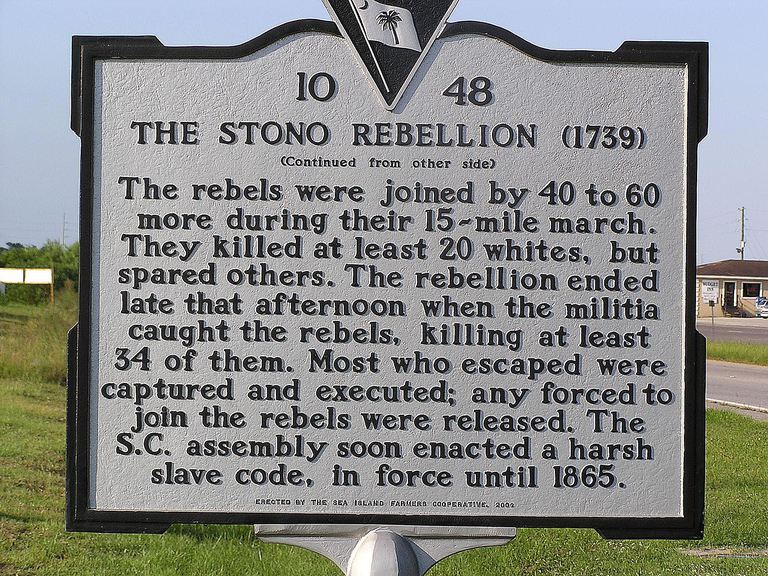
Violence and Resistance
African slaves were whipped, beaten, raped, hobbled, and castrated for the smallest of infractions. Their hands or arms would be cut off. Female slaves would endure being raped or having one of their breasts lopped off as a form of punishment. The punishment was almost always done in public as a lesson or warning to other slaves. You can only witness so much abuse before you would strike out against the abusers and Africans did just that in British colonial America. Whites had feared slave uprisings because whites experienced Indian uprisings when they initially tried to use Indians as slaves.
Some fled to Spanish Florida where they lived with the Creek Indians and formed a new people that the Spanish called “the Wild Ones” or Cimarron, Seminole in English. There were plenty of slave rebellions such as the Stono Rebellion hatched along the Stono River in South Carolina. The plan was to kill their master, then move south to Florida killing white slave owners along the way and freeing more slaves. Slaves killed some whites but were outnumbered and all were caught and executed. But, the Stono Rebellion was so fearful that the good people of South Carolina ended the importation of African slaves. From 1739 to 1749, very few slaves entered the Americas through Charleston. After ten years the people of South Carolina got over their fear and began the importation of Africans. Slave revolts were not limited to the South. In New York, slave revolts happened in 1712 and 1741. In 1714 23 rebellion slaves were killed, along with 9 white colonists. 70 slaves were arrested and 21 were executed. After the 1741 slave rebellion, the people of New York City began to outlaw slaves. But the 1712 slave revolt initiated a string of slave uprisings and counter-attacks by white mobs against Africans, sometimes free Africans, that would last for decades.[80]
Slavery and the Economics of Empire
Slave colonies produced 95% of all British exports between the establishment of Virginia to the American Revolution. That was a tremendous amount of wealth. And according to the mercantilism practices of the day, the raw resources would be turned into finished goods in England and then imported into the Americas to be purchased, thus creating new markets for English goods.[81] Slavery was not part of the culture of the North, thus northerners tended to be self-sufficient. They grew their own food. Made their own stuff. And what they could not grow, what they could not make, they did without. Slavery was part of the economic culture of the Chesapeake (in tobacco) and the lower South (rice, indigo, and tobacco, and eventually cotton). And until 1808 (when the importation of African slaves became against the law) it was simply cheaper to work slaves to death and but new ones than it was to take care of their slaves. Thus there was a growing, constant need for more and more African slaves, especially as Southerners pushed further and further West; cultivating new land, needing more slaves. Wealth was in the hands of the few. 10% of the population owned 60% of the land. Large plantation owners tended to be “old money” (from the House of Lords, for example) while half the population was small, family farmers. And 40% of colonists owned no land. Mercantilism was not a monolithic entity. Different regions responded differently and those economic differences, as I will talk about later, will result in the English acting as they will following the French and Indian War. For now, the north, the Chesapeake, and the South were affected by mercantilism differently based on a myriad of factors to include soil and make-up of those who settled the area.[82]
A Two-Tier System
In 2018 the federal government was “shut down” because Donald Trump wanted money to build a wall along the US-Mexico border. He refused to accept a bipartisan bill that would have kept the government running but provided no money for his wall, thus the government “shut down.” I put “shut down” in quotations because civil servants do not report to work during the “shut down” as they are not being paid. However, since the Clinton administration, the precedent has been for Congress to retroactively pay those civil servants after the government ends the “shut down.” In other words, civil servants will be getting a paid vacation. Now, the vast majority of people who work for the federal government are not protected workers who almost never be fired, but contractors who are at-will employees. When the government is “shut down” those contractors do not work and they do not get paid. But when Congress decides to give federal workers a paid vacation, they do not do so for the contractors thus in this country we have a two-tier system when it comes to working for the federal government. Those few who can secure a federal job get paid not to work and those who cannot secure a federal job will simply not get paid. Why is that the case? That’s a story for a much later chapter. During the colonial era, there was a two-tier system even for free Africans.
Why do we pass laws? In order to correct past actions. Laws are not forward-looking, rather they are backward-looking. We pass laws to stop people from acting in ways they used to be able to act. Thus before something becomes illegal, it was legal. In 1670, it became illegal in Virginia for free blacks to own Christian slaves. Which meant that before 1670, free blacks could own Christian slaves. Then Virgin passed laws prohibiting free blacks from voting, holding political office, and testifying in court, which means before that blacks could (and did) vote, hold political office, and testify in court. Such as the case of Anthony Johnson. Johnson was a free black, living in Virginia, who owned slaves. Johnson leased some slaves to a ship captain named Goldsmith. But Goldsmith did not return the slaves on time so Johnson sued Goldsmith in court in 1655. Johnson prevailed and Goldsmith was forced to pay Johnson for the extended use of his slaves. In 1691, in Virginia, it became illegal for interracial sexual relations. Remember, that one’s status was based on their mother’s status. If the baby’s mother was a slave, then the baby (even with a white father) was a slave. If the baby’s mother was free then the baby was free (even when the father was black).[83]
Honor was a public thing. Loss of honor required action or else family members would be shunned. Businesses would be avoided. A major loss of honor was when the slave owner would set a female slave up in her own home or be seen with her in public. Wives expected private relationships but when those relationships went public, the wives (the family) lost honor. In order to regain honor the wives would alert the authorities, the slave would be punished (whipped for example) for seducing her husband and maybe sold, thus regaining honor. Colonial authorities did not arrest white men when they fathered babies with slave women (this was simply a way for the slave owner to get more slaves). And thus was born the stereotype of Jezebel: young, female slaves who were sexually attracted to white men.[84] Other Stereotypes for African females developed during the colonial era to include the rotund, happy-go-lucky pancake flipping house servant “mammy,” the seemingly anti-male, ball-busting, exceptionally independent Sapphire, and others. These stereotypes will come back to view during the Blacksploitation era of Hollywood movies.[85][86]
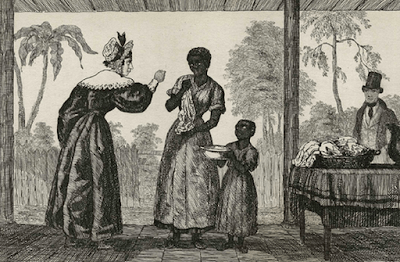
The Plantation Mistress[87]
Not only were southern women expected to meet, and exceed, the criteria of what a southern lady should be, but southern women were also expected to run the day-to-day operations of the plantation without any acknowledgment from society. Women were supposed to bear children, raise those children, take care of household duties all while still being expected to contribute outside of the home. The double roles women were demanded to accomplish in the past are still expected from them in this present day. Women now, in 2019, are expected to rear children, take care of house chores, and help provide income for the household, just as women in the antebellum era were expected to. All the demands performed by women with no acknowledgment from anyone are typical of a misogynistic society. Carrying out dual roles is simply what was, and is, expected.
Everything a woman did was to amplify the status and image of her husband, the plantation master. A southern lady was expected to be warm, gentle, and refined in her manner.[88] This was an image created by men who were infatuated with female innocence.[89] While female slaves did not have the same freedoms or the same standing in society as white women in the south, the oppression from males was still present. Female slaves worked the fields and were expected to tend to their slave cabins.
Women were objects useful only to raise the image of a man. This increase of land gained through marriage benefited the man, also known as the plantation master, but did not benefit the wife, the plantation mistress. The larger the amount of land, the more work the mistress was required to do. Women were left to tend to the land and the slaves.[90] Female slaves were to also tend to the land, or whatever duty the mistress assigned, and then expected to complete the customary woman duties in the slave cabins.[91]
Plantation masters viewed women and slaves as two sides of the same coin. Yes, southern women were free, but they were not viewed the same as white men. Plantation mistresses were just a step above slaves but could never attain the same social status as their male counterparts. George Fitzhugh, a theorist who published “Sociology for the South” in 1854, believed that if slavery was abolished or women became more free-thinking, then the end of the southern civilization would come.[92] Fitzhugh was not the only man in the south to believe this. Men did not want their wives or daughters to be educated and potentially speak out against slavery. After the Panic of 1837, a recession that lasted until 1843, southerners took their time in reopening educational academies that closed due to the recession.[93] When women academies did reopen, southerners spoke out against intellectual studies and showed more concern with social graces.[94]
The fear of women being introduced to northern ideas about slavery was so great that southern politicians, known as Dixiecrats, introduced a gag law to Congress to suppress any abolitionist resistance.[95] Plantation masters began to seclude their wives and confined them to the plantation. Women in the south became secluded from one another with their husbands guarding their whereabouts more than ever.[96]
Even men, such as David Campbell, who had a loving and warm relationship with his wife Maria and encouraged her to find entertainments that would lessen her sadness while he was away, did not approve of her outings to what he describes as Methodist class meetings.[97] From what is gathered from the text, Methodist meetings might be women who gather and oppose slavery. Campbell calls the women who attend those meetings “fanatics” and claims “he who gave us being cannot delight in such worship.”[98] Campbell uses God and religion to try and deter his wife from attending the meetings. This was a subtle way of him trying to control Maria. Southern men believed slavery was a God-given right and used that to justify their horrible actions.
Plantation mistresses were oppressed by their husbands and by society. They shared some similarities with female slaves but ultimately had a slight advantage. They both were isolated, used as a commodity to define wealth, and sold. Plantation masters feared the independence of women just as much as they feared the independence of slaves. Today, some men still fear the independence of women. Men with an antiquated ideology still believe their role is to procreate and have a job, while the woman shares the economic burden, raises the children, and tends the home. History shows not much have changed in regard to the way women are viewed by American society.
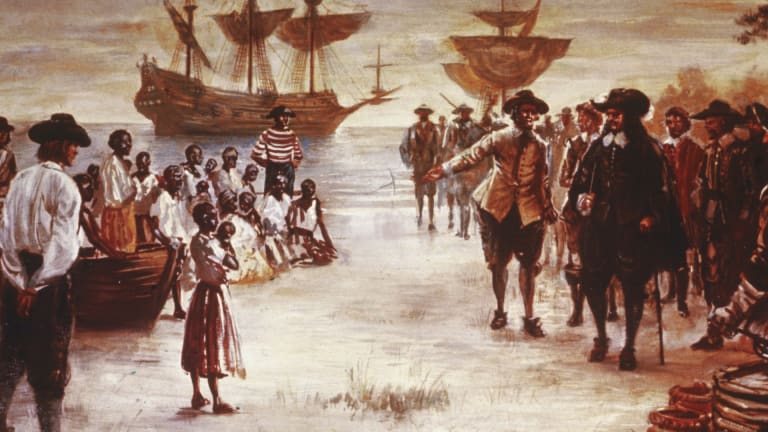
Law and Women of Color[99]
This looks at the cases of Elizabeth Key and Jenny Slew. Facing both gender and racial discrimination, these black women had the determination to become free. In 1656 Elizabeth Key, a Virginian, fought for her freedom by first claiming that as a Christian woman, she should not be a slave. However, that claim did not give her freedom. Her second argument was that her father was a free white Englishman. The legislators granted Key freedom until the administrators of her master’s estate filed an appeal. Enslaved, Key found another solution and gained her liberty by marrying her white lawyer. Key’s case showed the difference between men’s and women’s roles in society. Elizabeth Key’s ability to achieve her freedom through her marriage to a man rather than her proclamation of faith shows how the colony of Virginia views freedom as more connected to birth or marital status. Elizabeth Key’s case made way for arguments, that fought for the legal status of slaves. “In 1667, Virginia defined “negro” people as “separate” from Christians, closing off baptism and Christian conversion as a possible route to freedom for slaves.”[100] Key was able to gain her freedom through marriage before lawmakers began to discourage and make laws against marriage between white and black people. However, even though Key’s case was before Virginia defining Black people as separate from Christians, the belief still was prevalent in colonial society during her court case. Elizabeth Key, through the win and eventual loss, still found a way to be free.
Jenny Slew is another African American woman who fought for her freedom and who lost and eventually won her case. Slew is the daughter of a free white woman Betty Slew, and her father is a man of African descent, most likely to be a slave. Her earlier life is unknown except that she lived in freedom in Massachusetts until John Whipple Jr. kidnapped her and made her a slave in 1762. “Massachusetts specifically provided foreigners and the enslaved the right to bring suit and petition the court for unlawful enslavement.”[101] Jenny Slew, through slave’s rights, gained the ability to sue in her colony, made her case. In the first lawsuit, Jenny Slew accidentally filed her claim under the wrong jurisdiction and, in the fight, and was married at the time. John Whipple Jr. won the first case against Slew in the inferior court because she was married. Marriage, like in Elizabeth Key’s case, was significant because wives were to be dependent on their husbands. Slew lost her case and had to pay the court cost. That did not stop her from fighting for her freedom and filed an appeal to the superior court. Whipple’s argument remained the same against Slew in the superior court. Whipple said that he had proof of purchase, and as a married woman, her rights were nonexistent and to be under the authority of her husband. However, marriage as a slave is questionable and is not substantial, causing his claims to fail. Jenny Slew was able to win her freedom and the money she spent on the first trial as well. “She demanded not only her freedom but also damages in the number of twenty-five pounds. Although Jenny Slew lost her case initially, a year later on appeal she was awarded four pounds and court expenses.”[102] Jenny Slew stayed committed to her case and won in the end. In conclusion, women of color in colonies through racial and gender discrimination used what resources they had to become free and independent citizens. These black women’s longing for independence led them to fight for what they wanted in life and achieved it.
Sojourner Truth
Possibly the most well-known abolitionist who scanned the spectrum from enslavement to one who launched a “career” into more rights for all women. Amanda Williams (Summer, 2024) performed a thoughtful look at this person who sometimes is championed as part myth.
Sojourner Truth was a former slave who escaped to her freedom in 1826 and began her journey as an abolitionist advocating for women’s rights.[103] Despite having no formal education, Truth became a prominent figure in early history as an abolitionist, evangelist, advocate for women’s rights, and the first black woman to win a lawsuit against a white man.
Born into slavery in 1797, Sojourner Truth, originally named Isabella Bomfree, faced the brutal reality of being sold several times and endured harsh treatment.[104] Truth was born in New York to Dutch slaveholders alongside her enslaved parents where she spent the first nine years of her life. Truth would be auctioned off to an English-speaking family where she would begin enduring harsh punishments due to her primary language being Dutch, leading to her struggle of comprehending orders in English.[105] After being sold three more times, Truth would ultimately be sold to the Dumont family, where she would meet and marry her husband Thomas, give birth to five children, and remain enslaved from 1810-1826.[106]
In 1827, Truth seized the opportunity to flee with her child and escape enslavement.[107] Soon after her escape, Truth would discover that her son Peter was illegally sold into slavery. Truth filed a lawsuit with the Grand Jury of Kingston, New York, and Peter’s owner would be found guilty and ordered to return him to his mother immediately. Truth winning the lawsuit solidified her position as the first black woman to win a lawsuit against a white man, which further strengthened her ambition of joining the abolitionist movement.
Truth engrossed herself in religious practices and joined the abolitionist movement using her voice to advocate for ending slavery and the empowerment of women through speeches and lectures. In 1851, at The Woman’s Rights Convention, Truth delivered her legendary speech, “And Ain’t I A Woman,” advocating for equality of men and women.[108] Truth embarked on a speaking tour where she fervently spoke addressing issues such as slavery and women’s suffrage. She also felt a deep calling from God which inspired her religious evangelism. Truth worked beside the distinguished abolitionist, Fredrick Douglass, and was honored for her works by President Abraham Lincoln.
Truth inspired others through her works, dedication, and passion. She was relatable to others considering her struggles with illiteracy, her tumultuous life as a slave, and the inequalities of being a woman. Thus, as she overcame these challenges, her passion was driven by the desire of wanting to end slavery and promote equality.
Conclusion
Growing your own food, making your own stuff, and what you cannot grow and cannot make you do without, was part of the mentality of English colonists living in the northern half of the colonies. While liberty for southerners included the liberal use of unfree labor (slavery). Africans were considered less than civilized thus English men justified their use of Africans in the slave trade. The African slave trade also brought previously unknown wealth to many English colonists. And those who were already wealthy, such as George Washington and Thomas Jefferson, became exceptionally wealthy over the use of African slaves. Americans will not pause to reflect on their particular definitions of freedom or liberty and their application beyond white people until the American Revolution forces such a rethinking. When that happens, northern states will reject slavery, such as Vermont which made slavery illegal in 1777. The sectional mentality about and use of slavery was reflected in the section’s ideas on the need or relationship with Parliament. The North saw local government as best while the further South (and the more cash crop farming there was) the more likely the idea of a strong relation with England existed. At least for now.
I would like to thank my students, Alejandra Cantu, Sarea Crouch, Devin Dembley, Luis Gonzalez, Rory Harris, Laura Loredo, and Thomas Hudson, for their interest in antebellum gender history and slavery. I think they did a great job examining Catherine Clinton’s book, Plantation Mistress. Elizabeth Arriens, Amie Blanco, Roberto Bolanos, Arish Chandok, and Jazmyn Crawford-Lewis should be proud of their research into Pennslyvania slavery. And, Naiya Childs, Luna Amelia, Myska Nasiri, Selena Ordonez, Kathryn Page, Javier Martinez, Josue Perez, Jose Ramos, Lauren Rivas and Jesus Zayas looked at slavery in colonial New York. Excellent work all!
As with the other chapters, I have no doubt that this chapter contains inaccuracies. Please point them out to me so that I may make this chapter better. I am looking for contributors so if you are interested in adding anything at all, please contact me at james.rossnazzal@hccs.edu.
- The University of South Carolina maintains an online encyclopedia of South Carolina history. By the way, Trescot plays a larger role in the Sumter crisis than this entry has to say. http://www.scencyclopedia.org/sce/entries/trescot-william-henry/ ↵
- https://blackpast.org/aah/prince-lucy-terry-c-1732-1821 originally attributed to John Saillant, Black Puritan, Black Republican: The Life and Thought of Lemuel Haynes, 1753-1833 (New York: Oxford University Press, 2003). ↵
- Ibid. ↵
- https://www.pbs.org/wgbh/aia/part2/2p15.html ↵
- VT State Archives @VTStateArchives 2/2/18 Lucy Terry Prince, stolen from Africa & sold into slavery in RI, married Abijah Prince who bought her freedom in 1756. She was the 1st woman to successfully negotiate a case before the U.S. Supreme Court. Her obituary celebrates her "fluency of speech." #ArchivesBlackHistory #VT. Attached obituary dated July 11th no year. ↵
- VT State Archives VTStateArchives 2/2/18 She died in Sutherland #VT in 1821 & was remembered for her ballad, "Bars Fight," about a 1746 incident. It was preserved orally until being published in 1855. It is considered the oldest known work of literature by an African American. #ArchivesBlackHistory ↵
- http://www.history.org/almanack/people/african/aaintro.cfm ↵
- Edgar A. Toppin. "Blacks in the American Revolution" (published essay, Virginia State University, 1976), p. 1 and see http://www.tep-online.info/laku/usa/mino/1790.htm ↵
- http://www.tep-online.info/laku/usa/mino/1790.htm ↵
- Ibid. ↵
- Ibid. and see Compton's Encyclopedia Online http://www.comptons.com/encyclopedia/) ↵
- https://www.pbs.org/wgbh/aia/part1/1narr2.html ↵
- https://www.pbs.org/wgbh/aia/part1/1p277.html ↵
- http://www.digitalhistory.uh.edu/disp_textbook.cfm?smtid=2&psid=451 ↵
- Ibid. ↵
- http://librarycompany.org/catalogs/Education of African Americans in Franklin's Philadelphia.pdf ↵
- Wagman, Morton. “Corporate Slavery in New Netherland.” The Journal of Negro History 65, no. 1 (1980): 34–42. https://www.jstor.org/stable/3031546 [Accessed September 28, 2021.] ↵
- Ibid., 34. ↵
- Ibid., 36. ↵
- Ibid., 38. ↵
- Ibid., 38. ↵
- Ridell, William Renwick. “The Slave in Early New York.” The Journal of Negro History, vol. 13, no. 1, Association for the Study of African American Life and History, Inc., 1928, pg.56 ↵
- Hirsch, Leo H. “The Slave in New York.” The Journal of Negro History vol. 16, no. 4, Association for the Study of African American Life and History, Inc., 1931 pg.383 ↵
- Ridell, William Renwick. “The Slave in Early New York.” The Journal of Negro History, vol. 13, no. 1, Association for the Study of African American Life and History, Inc., 1928, pg.67 ↵
- Olson, Edwin. “The Slave Code in Colonial New York.” The Journal of Negro History 29, no. 2 (1944): 147–65. <https://www.jstor.org/stable/2715308> [Accessed September 28, 2021] ↵
- Ibid., 148. ↵
- Ibid., 149. ↵
- Ibid., 151. ↵
- Edwin, Morgan. Slavery in New York (Pennsylvania State University: G. P. Putnam's Sons, 1898), 13. ↵
- Carter, Linda M. “Jupiter Hammon.” Guide to Literary Masters & Their Works, Salem Press, 2007, pg1 ↵
- Faherty, Duncan F. “Hammon, Jupiter.” American National Biography, printed 1999, published online 2000, pg.1 ↵
- Written by Laura Lorado, Fall of 2022 ↵
- E.B O’Callaghan, “The African Experience in Colonial America”, American Perspectives: Readings in History Vol 1, (1638-1674); 112. ↵
- Ibid., p. 112 ↵
- E.B O’Callaghan, “The African Experience in Colonial America”, American Perspectives: Readings in History Vol 1, (1638-1674); 112. ↵
- Ibid., p. 3 ↵
- Ibid., p. 34 ↵
- Ibid. ↵
- Ibid. ↵
- Ibid., p. 44 ↵
- Miller, M. Sammy. “The Negro in Delaware.” Negro History Bulletin 36, no. 3 (1973): 66. http://www.jstor.org/stable/44176265. 9/3/2022 ↵
- Ibid. ↵
- Ibid. ↵
- By Estrella Mac, Fall 2022 ↵
- Hallam, Jennifer. The Slave Experience: Men, Women, and Gender. np ↵
- National Humanities Center. On Slaveholders' Sexual Abuse of Slaves. (Hilliard Yellerday, interviewed ca. 1937). p. 3. ↵
- Millet, Trevor M. Slavery in New Netherland. (History of American Women, 2017), np. ↵
- Ibid. ↵
- Ware, Laura. Traditional Gender Roles and Slavery. (Class Research, Spring 2015), 4. ↵
- Millet, Trevor M. 2017. ↵
- Hallam, Jennifer, 2. ↵
- Ibid, 11. ↵
- by Elizabeth Arriens, Amie Blanco, Roberto Bolanos, Arish Chandok, and Jazmyn Crawford-Lewis ↵
- "The Growth of Slavery” American History. U.S. History Pre-Columbian to the New Millennium (Philadelphia: 1942) https://www.ushistory.org/us/6c.asp ↵
- Turner, Edward Raymond. "Slavery in Colonial Pennsylvania." The Pennsylvania Magazine of History and Biography 35, no. 2 (1911): 141-51. Accessed August 28, 2021. http://www.jstor.org/stable/20085542. ↵
- Turner, Edward Raymond. "The Abolition of Slavery in Pennsylvania." The Pennsylvania Magazine of History and Biography 36, no. 2 (1912): 129-42. Accessed August 28, 2021. http://www.jstor.org/stable/20085586. ↵
- Parry, Tyler D.“How right-wing talking points distort the history of slavery” Washington Post. Module 2 Readings (Fullerton: 2019) https://www.washingtonpost.com/outlook/2019/06/25/how-right-wing-talking-points-distort-history-slavery/?noredirect=on&utm_term=.7ea498831198 Accessed September 27, 2021. ↵
- Ibid, 141-151 ↵
- Ibid, 141-151 ↵
- “Free African Americans in the Colonial Era” American History. U.S. History Pre-Columbian to the New Millennium (Philadelphia: 1942) https://www.ushistory.org/us/6e.asp ↵
- Ibid, 141-151 ↵
- Slave Life on the Farm and in the Town” American History. U.S. History Pre-Columbian to the New Millennium (Philadelphia: 1942) https://www.ushistory.org/us/6d.asp ↵
- Ibid, 141-151 ↵
- “Quakers in Pennsylvania and New Jersey” American History. U.S. History Pre-Columbian to the New Millennium (Philadelphia: 1942) https://www.ushistory.org/us/4b.asp ↵
- Ibid, 141-151 ↵
- Ingersoll, C. “African Slavery in America” African Slavery in America, (Philadelphia: 1856): 10. Accessed September 27, 2021. https://eagleonline.hccs.edu/courses/168895/pages/oer-textbooks-and-ancillaries?module_item_id=9352277 ↵
- Ibid, 129-142 ↵
- Susan Hogan, “In the belly of hell’: The Quaker abolitionist disowned by his faith for condemning slave owners,” The Washington Post, (May 14, 2018) <https://www.washingtonpost.com/news/retropolis/wp/2018/05/14/in-the-belly-of-hell-the-quaker-abolitionist-disowned-by-his-faith-for-condemning-slave-owners/> [accessed January 24, 2023]. ↵
- Society of Germantown Friends, ”Germantown Friends' protest against slavery,” Library of Congress (1688) ↵
- A. Mackraby, "Philadelphia Society before the Revolution." The Pennsylvania Magazine of History and Biography 11(4): 491-94. (1888) http://www.jstor.org/stable/20083235 [accessed January 24, 2023]. ↵
- William L. Andrews, Sisters of the Spirit: Three Black Women's Autobiographies of the Nineteenth Century, (Bloomington and Indianapolis: Indiana University Press, 1986) 50. ↵
- Hogan, "In the Belly of Hell" ↵
- This piece on PA was researched and written by Leola Judge. ↵
- David Welna, “What Is No Longer in a Name: Rhode Island Official Docs Shed Racially Loaded Moniker,” NPR (NPR, June 23, 2020), https://www.npr.org/sections/live-updates-protests-for-racial-justice/2020/06/23/882473020/what-is-no-longer-in-a-name-rhode-island-official-docs-shed-racially-loaded-moni ↵
- Olivia B. Waxman, “First Slavery Ban: Why Rhode Island's 1652 Law Was Ignored,” Time (Time, May 18, 2017), https://time.com/4782885/rhode-island-antislavery/ ↵
- The Elusive Guineamen: Newport Slavers, 1735-1774 on JSTOR, accessed January 26, 2023, https://doi.org/10.2307/365360 ↵
- Deutsch, Sarah, 235. ↵
- David Welna, 2020. ↵
- https://en.wikipedia.org/wiki/African-American_Vernacular_English See 'Origins' ↵
- https://www.smithsonianmag.com/smart-news/new-york-slave-revolt-1712-was-bloody-prelude-decades-hardship-180958665/ ↵
- https://www.investopedia.com/ask/answers/041615/how-did-mercantilism-affect-colonies-great-britain.asp ↵
- http://www.digitalhistory.uh.edu/teachers/lesson_plans/pdfs/unit1_4.pdf ↵
- https://www.encyclopediavirginia.org/Court_Ruling_on_Anthony_Johnson_and_His_Servant_1655 ↵
- https://www.ferris.edu/HTMLS/news/jimcrow/jezebel/index.htm ↵
- https://academic.udayton.edu/race/05intersection/Gender/AAWomen01a.htm Last accessed 9 Jan 2019 ↵
- https://scholarsarchive.byu.edu/cgi/viewcontent.cgi?article=1257&context=criterion Last accessed 9 Jan 2019 ↵
- This passage was written by Alejandra Cantu, Sarea Crouch, Devin Dembley, Luis Gonzalez, Rory Harris and Thomas Hudson ↵
- Catherine Clinton, The Plantation Mistress (New York: Pantheon Books, 1982), eISBN 978-0-307-77248-0, page 37. ↵
- Ibid., 108. ↵
- Ibid., 39. ↵
- Ibid., 222. ↵
- Ibid., 34. ↵
- Ibid. ↵
- Ibid. ↵
- Ibid. 35. ↵
- Ibid. 36. ↵
- Ibid., 33. ↵
- Ibid. ↵
- by Therese Moore, Spring 2020. ↵
- West, Emily. 2014. Enslaved Women in America: From Colonial Times to Emancipation. Lanham: Rowman & Littlefield Publishers: 26. ↵
- Sinha, Manisha. 2016. The Slave's Cause: A History of Abolition. New Haven: Yale University Press :67. ↵
- Horton, James Oliver. "Freedom's Yoke: Gender Conventions among Antebellum Free Blacks." Feminist Studies 12, no. 1 (1986): 54. ↵
- Murphy, Larry G. “Sojourner Truth: A Biography”, January 20, 2011. https://books.google.com/books?hl=en&lr=&id=XIHDEAAAQBAJ&oi=fnd&pg=PP1&dq=Sojourner+Truth+larry+murphy&ots=lFLynm1JSd&sig=G-5REEVwuuOjJ8JxLsOxbr09XdQ#v=onepage&q=Sojourner%20Truth%20larry%20murphy&f=false. ↵
- Truth, Sojourner. “Narrative of Sojourner Truth: A Northern Slave, Emancipated from Bodily Servitude by the State of New York, in 1828 / with a Portrait.”, HathiTrust, 1853. https://babel.hathitrust.org/cgi/pt?id=mdp.39015071140142&seq=19. ↵
- Mabee, Carleton. “Sojourner Truth, Bold Prophet: Why Did She Never Learn to Read?”, page number 4, JSTOR, January 1988. https://0-www-jstor-org.librus.hccs.edu/stable/23178487?seq=4. ↵
- Murphy, Larry G. “Sojourner Truth: A Biography”, January 20, 2011. https://books.google.com/books?hl=en&lr=&id=XIHDEAAAQBAJ&oi=fnd&pg=PP1&dq=Sojourner+Truth+larry+murphy&ots=lFLynm1JSd&sig=G-5REEVwuuOjJ8JxLsOxbr09XdQ#v=onepage&q=Sojourner%20Truth%20larry%20murphy&f=false. ↵
- Truth, Sojourner. “Narrative of Sojourner Truth: A Northern Slave, Emancipated from Bodily Servitude by the State of New York, in 1828 / with a Portrait.”, HathiTrust, 1853. https://babel.hathitrust.org/cgi/pt?id=mdp.39015071140142&seq=47. ↵
- Zackodnik, Teresa. “I Don’t Know How You Will Feel When I Get through’: Racial Difference, Woman’s Rights, and Sojourner Truth.” JSTOR, Spring 2004. https://0-www-jstor-org.librus.hccs.edu/stable/3178558?searchText=Sojourner+Truth+aint+i+a+woman+speech&searchUri=%2Faction%2FdoBasicSearch%3FQuery%3DSojourner%2BTruth%2Baint%2Bi%2Ba%2Bwoman%2Bspeech%26so%3Drel&ab_segments=0%2Fbasic_search_gsv2%2Fcontrol&refreqid=fastly-default%3Afcfb0aa0b9af40419ba121f3961f0639&seq=2. ↵
